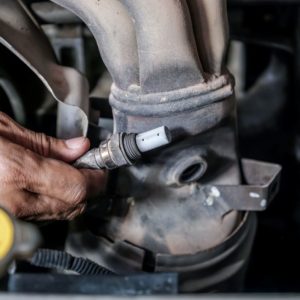One type of sensor that provides critical data to the PCM is the oxygen sensor. The upstream oxygen sensor tracks the amount of air in the engine to determine whether it is running in a rich or lean condition. If the PCM identifies an issue in the signals coming from this sensor, it may log the P2198 code.
Below is some general information about the P2198 code that can help you understand the possible causes of this trouble code and how to fix it.
What Does the P2198 Code Mean?
Diagnostic trouble code (DTC) P2198 stands for “O2 Sensor Signal Biased/Stuck Rich (Bank 2 Sensor 1). It is triggered when the PCM detects that the signal produced by the upstream sensor has been relaying a rich condition (too much fuel) for an extended period.
This DTC refers to the oxygen sensor that measures the oxygen levels of the exhaust stream between the engine and catalytic converter. It does not refer to the downstream oxygen sensor behind the converter.

An upstream zirconia oxygen sensor continually produces a signal that switches between rich (above 0.45 volts) and lean (below 0.45 volts). If the PCM determines that the sensor consistently produces a signal above 0.45 volts, it will set the code P2198.
Make sure you know exactly where bank 1 and bank 2 are before you attempt any DIY diagnosis or troubleshooting for code P2198. Reading up on lean and rich trouble codes as well as air-fuel mixture can also give you more knowledge that can help you understand P2198 better if you’re thinking about fixing it yourself.
Note: The definition of code P2198 may be different depending on the vehicle manufacturer. Consult the appropriate repair manual or repair database for the exact code definition.
What are the Possible Causes of the P2198 Code?
- Oxygen sensor failure
- Wiring issue or poor connection
- Rich running condition (e.g., fuel pressure too high or a leaking fuel injector)
- PCM failure
- PCM software needs to be updated

What are the Common Symptoms of the P2198 Code?
- Check Engine Light is illuminated
- Poor engine performance, such as rough running and lack of acceleration
- Increased fuel consumption
How to Diagnose the P2198 Code
Identifying the underlying cause of the P2198 code can be difficult, especially if you’re not confident with your automotive knowledge. In most cases, it would be best to bring your vehicle to an auto repair shop and seek the help of a professional for an accurate diagnosis.
Here is a video that can help give you a better idea of how this trouble code may be diagnosed:
How to Fix the P2198 Code
The P2198 code is a generic trouble code that may apply to various makes and models. While vehicles from different manufacturers may share common symptoms, the steps for diagnosis and repair for a P2198 Ford code may differ from a P2198 Toyota code.
If you’re an advanced DIYer who’d like to fix this code on your own, it will be helpful to refer to your repair manual or get factory vehicle repair information from an online subscription service.
Where To Get Parts To Resolve the P2198 Code
Oftentimes you’ll find that the P2198 code is caused by a faulty oxygen sensor or wiring issues, leading to decreased vehicle performance and increased fuel consumption. To address the P2198 code and return your vehicle’s performance to what it once was, you might need to replace its problematic parts. Thankfully, ordering new parts is easy at CarParts.com.
Ordering parts from CarParts.com takes just a few clicks. Our vehicle selector allows you to enter your vehicle’s year, make, and model to ensure you only get parts that fit. With our 60-day return policy and price match guarantee, you can make your purchases with confidence at CarParts.com. Get your money’s worth by picking from our wide selection of quality aftermarket parts. If you have questions or concerns, we offer round-the-clock support through our friendly and helpful customer service team.
Place your order for a new oxygen sensor and other parts at CarParts.com today.
Products Mentioned in this Guide
Shop this Project



Any information provided on this Website is for informational purposes only and is not intended to replace consultation with a professional mechanic. The accuracy and timeliness of the information may change from the time of publication.


 Catalytic Converter
Catalytic Converter
 Oxygen Sensor
Oxygen Sensor
 Engine Control Module
Engine Control Module



















